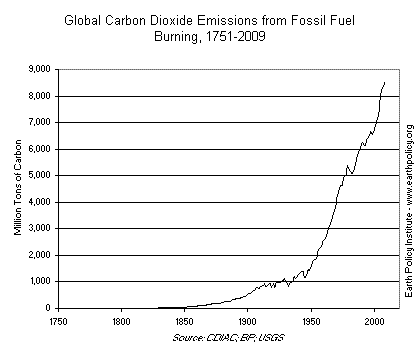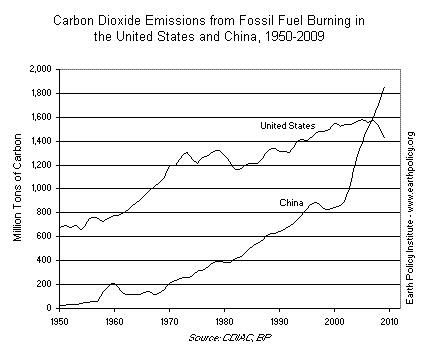"It's the best summation of humanity's converging ecological problems and the best roadmap to sovling them, all in one compact package." —David Roberts, Grist on Plan B 4.0: Mobilizing to Save Civilization.
Past Decade Still Sees Rapid Emissions Growth
Click here to view the most recent Carbon Emissions Indicator and Data
In 2009, carbon dioxide (CO2) emissions in China—the world’s leading emitter—grew by nearly 9 percent. At the same time, emissions in most industrial countries dropped, bringing global CO2 emissions from fossil fuel use down from a high of 8.5 billion tons of carbon in 2008 to 8.4 billion tons in 2009. Yet this drop follows a decade of rapid growth: over the 10 previous years, global CO2 emissions rose by an average of 2.5 percent a year—nearly four times as fast as in the 1990s. Increasing temperatures and the resulting melting ice sheets and rising sea levels demonstrate the destructive effects of the carbon accumulating in the atmosphere.
Emissions in many wealthier countries fell in 2008 and 2009 as the global recession took hold. In the United States, CO2 emissions shrank by nearly 10 percent from 2007 to 2009, from a high of 1.58 billion tons of carbon to 1.43 billion tons, the lowest level since 1995. Emissions from oil, which is largely used for transportation, declined by nearly 11 percent, while those from coal, which is mainly burned to generate electricity, fell by over 13 percent.
The United Kingdom’s CO2 emissions fell by over 10 percent from 2007 to 2009. German emissions dropped by 8 percent, and French emissions dropped by 5 percent. Japan saw its emissions decline nearly 12 percent over the two-year period. (See data.)
At the same time, CO2 emissions in the world’s most populous countries, China and India, continued to grow rapidly. China’s emissions rose to 1.86 billion tons of carbon in 2009, representing nearly a quarter of global emissions from fossil fuel burning. With average annual emissions growth of 8 percent over the past decade, China overtook the United States in 2007 as the world’s leading CO2 emitter. India’s emissions grew by close to 5 percent a year over the past decade; the country passed Russia in 2007 to become the world’s third largest emitter.
Still, emissions per person in developing economies remain far below those of most of the industrial world. The tiny nation of Qatar ranks highest in per capita emissions, at 11.5 tons of carbon per person in 2009, followed by several other oil-rich countries. Australia, the United States, and Canada lead the major industrial countries, emitting 4–5 tons of carbon per person in 2009. Per capita emissions in these countries are three times those in China and nearly four times the world average. At the same time, many European countries, such as the United Kingdom, Germany, and France, have comparable standards of living to the United States but emit only half as much carbon dioxide per person.
Emissions totals for individual countries include all fossil fuels burned within their borders. For manufacturing giants like China, this means that their total emissions include those resulting from the production of goods destined for other countries. A recent study by researchers at Stanford University found that 22 percent of Chinese emissions resulted from the production of goods for export. The study also found that the manufacture of goods imported by the United States was responsible for 190 million tons of carbon emissions per year. If emissions totals were adjusted to account for Chinese exports and U.S. imports, the United States would again be the world’s leading emitter.
While fossil fuel use is responsible for the majority of carbon dioxide emissions, changes in land use, such as clearing forests for cropland, also emit a substantial amount of CO2. In 2008, the most recent year for which data are available, global emissions from land use change were estimated at 1.2 billion tons of carbon. The vast majority of these emissions were from deforestation in the tropics; Indonesia and Brazil alone represent over 60 percent of land use change emissions.
More than half of the carbon dioxide emitted annually is absorbed by oceans, soils, and trees. The rapid rate at which carbon dioxide is pouring into the atmosphere is overwhelming these natural systems, posing a particular threat to ocean ecosystems. The large amounts of dissolved CO2 alter ocean chemistry, making seawater more acidic, which makes it more difficult for organisms such as reef-building corals or shellfish to form their skeletons or shells. The world’s oceans are now more acidic than they have been at any time in the past 20 million years. Experts have estimated that if CO2 emissions continue to rise on their long-term trajectory, coral reefs around the world may be dying off by 2050.
Recent research has also indicated that the oceans’ capacity to absorb carbon dioxide may be unable to keep up with the rising level of emissions. The CO2-absorption ability of both the Southern Ocean, which surrounds Antarctica, and the North Atlantic Ocean has decreased in recent decades.
The carbon dioxide that is not absorbed by these natural sinks remains in the atmosphere, where it traps heat. The level of carbon dioxide in the atmosphere, which stood between 260 and 285 parts per million (ppm) from the beginning of agriculture until the Industrial Revolution, has risen rapidly in the last two-and-a-half centuries, to over 387 ppm today. The last time carbon dioxide levels were this high was roughly 15 million years ago, when sea level was 25–40 meters (80–130 feet) higher and global temperatures were 3–6 degrees Celsius (5–11 degrees Fahrenheit) warmer.
The increase in atmospheric CO2 has driven a rapid rise in global temperature: each decade over the past half-century has been hotter than the last. Responses to these rising temperatures have already been documented in melting glaciers and ice sheets, shifting weather patterns, and changes in the timing of seasonal events.
While much of the global emissions drop in 2009 was due to declining fossil fuel use associated with the recession, the past year also saw strong growth in the use of renewable energy. Installed wind capacity alone grew by over 30 percent worldwide. In the United States, where coal use dropped by more than 13 percent from 2007 to 2009, over 200 new wind farms came online during the same period, adding more than 18,000 megawatts of capacity. With hundreds of billions of dollars in stimulus funds allocated for clean energy and energy efficiency projects worldwide, this growth will continue in the years ahead.
However, evidence is mounting that faster, more substantial action is needed. The Intergovernmental Panel on Climate Change (IPCC), an international body of over 2,500 scientists, has modeled a number of scenarios for possible emissions growth in the coming decades. The likely rise in temperature projected in these scenarios ranges from 1.1 to 6.4 degrees Celsius (2-11 degrees Fahrenheit) by the end of the century. Even with the recent drop, carbon dioxide emissions continue to track some of the worst-case IPCC scenarios. Increasing numbers of scientists agree that atmospheric CO2 must be stabilized at 350 ppm or less; in order to achieve this goal, a fundamental shift in course is needed—and quickly.
The question going forward, then, is whether the international community can move carbon dioxide emissions onto a rapid downward trend by decoupling economic growth from fossil fuel emissions. Otherwise, it is likely that emissions will rise again as the global economy recovers, further destabilizing the earth’s natural systems. Only by shifting to a new energy economy, one that relies on carbon-free sources of energy such as wind, solar, and geothermal instead of climate-threatening fossil fuels, can we avoid the worst effects of climate change.



 Print:
Print:  Email
Email


